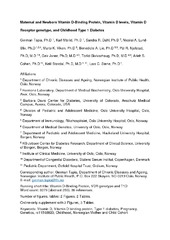Maternal and Newborn Vitamin D-Binding Protein, Vitamin D Levels, Vitamin D Receptor Genotype, and Childhood Type 1 Diabetes
Tapia, German; Mårild, Karl Staffan; Dahl, Sandra Rinne; Lund-Blix, Nicolai Andre; Viken, Marte K; Lie, Benedicte Alexandra; Njølstad, Pål Rasmus; Joner, Geir; Skrivarhaug, Torild; Cohen, Arieh S; Størdal, Ketil; Stene, Lars Christian Mørch
Peer reviewed, Journal article
Accepted version

Åpne
Permanent lenke
https://hdl.handle.net/1956/19832Utgivelsesdato
2019-04Metadata
Vis full innførselSamlinger
Originalversjon
https://doi.org/10.2337/dc18-2176Sammendrag
OBJECTIVE Circumstantial evidence links 25-hydroxy vitamin D [25(OH)D], vitamin D–binding protein (DBP), vitamin D–associated genes, and type 1 diabetes (T1D), but no studies have jointly analyzed these. We aimed to investigate whether DBP levels during pregnancy or at birth were associated with offspring T1D and whether vitamin D pathway genetic variants modified associations between DBP, 25(OH)D, and T1D. RESEARCH DESIGN AND METHODS From a cohort of >100,000 mother/child pairs, we analyzed 189 pairs where the child later developed T1D and 576 random control pairs. We measured 25(OH)D using liquid chromatography–tandem mass spectrometry, and DBP using polyclonal radioimmunoassay, in cord blood and maternal plasma samples collected at delivery and midpregnancy. We genotyped mother and child for variants in or near genes involved in vitamin D metabolism (GC, DHCR7, CYP2R1, CYP24A1, CYP27B1, and VDR). Logistic regression was used to estimate odds ratios (ORs) adjusted for potential confounders. RESULTS Higher maternal DBP levels at delivery, but not in other samples, were associated with lower offspring T1D risk (OR 0.86 [95% CI 0.74–0.98] per μmol/L increase). Higher cord blood 25(OH)D levels were associated with lower T1D risk (OR = 0.87 [95% CI 0.77–0.98] per 10 nmol/L increase) in children carrying the VDR rs11568820 G/G genotype (Pinteraction = 0.01 between 25(OH)D level and rs11568820). We did not detect other gene-environment interactions. CONCLUSIONS Higher maternal DBP level at delivery may decrease offspring T1D risk. Increased 25(OH)D levels at birth may decrease T1D risk, depending on VDR genotype. These findings should be replicated in other studies. Future studies of vitamin D and T1D should include VDR genotype and DBP levels.